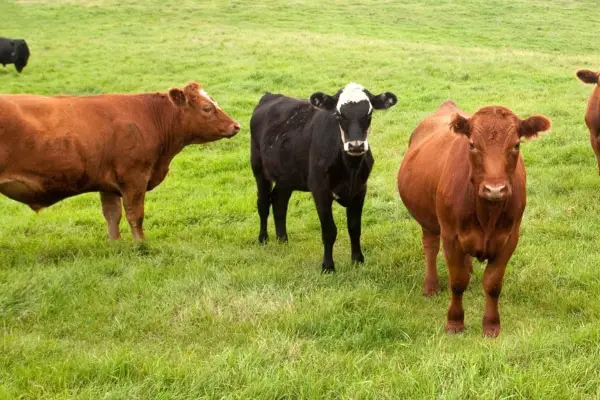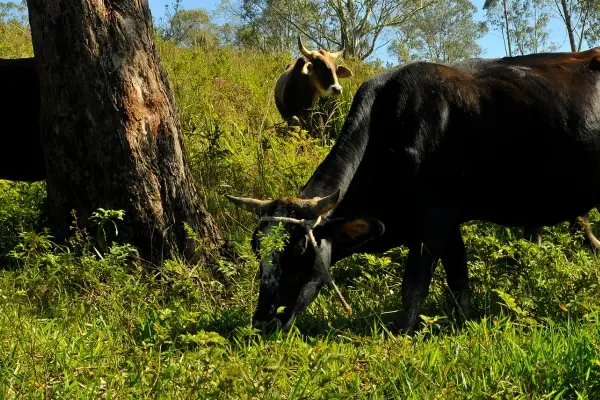Benefits of Raising Grass-Fed Cattle
Grass-fed beef is meat that comes from cows that have spent their entire lives grazing on pasture. Unlike conventional cattle that are often fed corn, soy, and other grains to fatten them up quickly, grass-fed cows get all their nutrients from grass, hay, and other fresh forage.
As consumer interest grows regarding where food comes from and how it is produced, grass-fed beef has surged in popularity due to perceived health, environmental, ethical, and taste advantages.
Demand for grass-fed beef has steadily risen over the past decade. According to some estimates, retail sales have grown from $17 million in 2012 to over $480 million in 2019. Grass-fed currently accounts for approximately 3-5% of the total beef market in the U.S., but that number continues rising year over year.
Many factors are driving this growth for grass-fed beef. Consumers are becoming more concerned about not only their own personal health, but also the treatment of animals and sustainability practices.
Grass-fed beef delivers advantages across all these areas compared to conventional beef production. When cattle are raised on open pastures eating grass their whole lives as nature intended, the end result is a nutritious, humanely raised product from a cow that led a good life.
Nutritional Benefits of Grass-Fed Cattle
Several scientific studies have shown that grass-fed beef delivers superior nutritional quality over grain-fed beef:
Higher nutrient content:
Grass-fed beef contains higher levels of key vitamins and minerals like vitamin A, vitamin E, calcium, magnesium, potassium, and antioxidants like glutathione and superoxide dismutase. It provides more conjugated linoleic acid (CLA), a type of heart-healthy fatty acid.
Grass-fed beef is also higher in omega-3 fatty acids up to four times higher than grain-fed beef depending on season and region. Omega-3’s support overall health and cognitive function.
Lower in calories and saturated fat:
beef from grass-fed cattle is typically lower in total fat and calories while having higher protein levels. It also contains lower amounts of saturated fats linked to heart disease.
Potential health benefits:
The nutritional differences in grass-fed beef may deliver valuable health advantages. Early research indicates grass-fed beef consumption can help lower cholesterol, reduce the risk for cancer and heart disease, curb inflammation, and aid with nutrient absorption.
While research is still ongoing in this area, the promising health benefits are another reason consumers are switching to grass-fed beef.

Environmental Benefits of Grass-Fed Cattle
In addition to nutritional advantages, grass-fed beef production delivers important environmental gains:
Reduced greenhouse gas emissions:
Raising grass-fed cattle generates substantially lower amounts of greenhouse gases like carbon dioxide and nitrous oxide. When cows graze on well-managed pastures, their methane emissions are offset by the carbon dioxide that grass plants absorb.
Improved soil health and biodiversity:
Rotating cattle across pastures provides natural fertilization from manure while aerating soil and promoting vegetation growth. This supports soil health and biodiversity while reducing reliance on synthetic fertilizers. Diverse native grasses sequester carbon and minimize runoff too.
More sustainable land-use practices:
Using cattle to convert inedible grasses growing on marginal land into nutritious beef is an efficient way to feed people without expanding croplands for feed production. Well-managed grazing practices can regenerate overgrazed areas over time as well. This supports more sustainable land-use systems.
With environmental issues like climate change and biodiversity loss intensifying, the planet-friendly benefits of pasture-raised cattle are increasingly valued.
Ethical Considerations of Raising Grass-Fed Cattle
Consumers also appreciate grass-fed beef production for animal welfare and ethical reasons:
Animal welfare – access to pasture, humane treatment:
When raised on open pastures, cattle can exhibit their natural behaviors like grazing, roaming, and socializing. Grass-fed cattle have far more freedom and space compared to feedlots. They live outdoors in fresh air and sunshine year-round, which reduces stress, disease, and mortality rates.
Antibiotic and hormone use:
Grass-fed cattle farming rarely uses antibiotics or growth hormones that are common in concentrated animal feeding operations (CAFOs). This reduces the risk of developing antibiotic-resistant “superbugs”.
Supporting smaller, independent farms:
The grass-fed beef industry provides opportunities for smaller-scale regional cattle farmers. Consumers connecting directly with local producers helps smaller farms survive against commodity giants.
By purchasing grass-fed beef, thoughtful consumers can help shift support towards more ethical and sustainable cattle-raising practices that benefit animals, people, and the planet.

Taste and Texture of Grass-Fed Beef
In terms of palatability, grass-fed beef delivers a different eating experience from what most consumers are used to:
Different flavor profile – gamey, leaner, less marbling:
Grass-fed beef has a fuller “beefy” flavor closer to wild game meat. With less intramuscular fat, the taste comes more from the meat itself rather than the buttery richness of fat marbling you get with grain-finished beef.
Cooking tips for grass-fed beef:
The leanness of grass-fed beef means it can overcook quickly if high heat is used. Cook it gently using methods like braising and stewing. Pieces should not be cooked past medium or they become tough. Moist cooking techniques deliver the best texture.
Considerations for different dishes and preferences:
The unique flavor and texture of grass-fed beef lends better to certain dishes and personal tastes. Less tender cuts work well when slow-cooked for stews or braised dishes. Those who prefer leaner meats appreciate grass-fed’s lower overall fat content.
For people accustomed to the taste of corn-fed beef, grass-fed may take some getting used to. Its flavor and texture are quite different. When properly prepared however, many come to strongly prefer grass-fed beef after adjusting to the initial change.
Cost and Availability of Grass-Fed Beef
Compared to conventional grain-finished beef, grass-fed currently costs more:
Higher price point compared to grain-fed beef:
Because smaller regional farms produce most grass-fed beef and cattle gain weight slower eating grass, it costs more to raise per pound compared to intensive feedlot production. Consumers pay the difference at retail.
Finding grass-fed beef near you – farmers markets, butchers, online retailers:
While availability keeps improving to meet demand, finding high-quality grass-fed beef can still pose challenges for some consumers depending on geographic region. Farmers markets, specialty butchers, natural grocers, and online mail order retailers offer the widest selection and ability to connect directly with producers.
Despite the higher prices, consumers are clearly demonstrating their willingness to pay premiums for grass-fed beef thanks to better nutrition, planet-friendly farming practices, humane animal treatment, and appealing culinary qualities.

The Future of Grass-Fed Cattle Farming
While still a small segment overall, grass-fed beef continues expanding as more consumers align personal values with food choices:
Growing demand and market trends:
Sales of certified grass-fed beef grew by 37% from 2017 to 2019 according to Nielsen data. High-end restaurants feature grass-fed beef on menus to meet customer demand as well. The strong growth trajectory is expected to continue.
Challenges and opportunities for the industry:
Rising consumer demand for grass-fed beef provides opportunities for expansion into new markets. However costs of production and thin profit margins provide challenges.
Lack of infrastructure for small farmers to process, distribute, and market grass-fed beef products creates difficulties too but programs supporting regional food systems help.
Supporting sustainable and ethical beef production:
Consumers can support responsible farming practices by seeking out and paying fair prices for grass-fed beef products. Encouraging the production of grass-fed beef over feedlot beef via dollars spent ultimately helps shift more cattle farms to utilize sustainable grazing practices. This market-driven support enables the grass-fed cattle industry to thrive.
Conclusion: Beyond the Benefits
Shoppers now view grass-fed beef as more than just a premium meat choice but as a conscious food decision aligning health, environmental, ethical, and taste priorities:
Grass-fed beef as a conscious choice – health, environment, ethics:
Consumer interest in grass-fed beef goes deeper than superficial trends. They understand the way cattle are raised impacts personal and planetary health. Choosing grass-fed beef allows values like nutrition, sustainability, humane animal welfare, and small farmer support to factor into purchase decisions.
Encouraging responsible and sustainable beef consumption:
If more cattle farms adopt grazing practices to meet demand, the broader environmental and ethical impacts of beef production improve. Consumers can play a part by supporting farmers who raise cattle on grass and forgoing feedlot-produced beef.
By consciously deciding to purchase grass-fed beef, everyday shoppers can feel good knowing their dollars help drive transformational changes towards more responsible and sustainable cattle farming.


